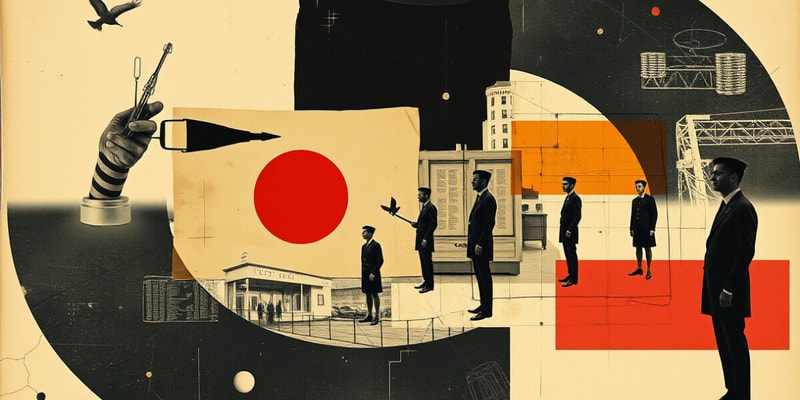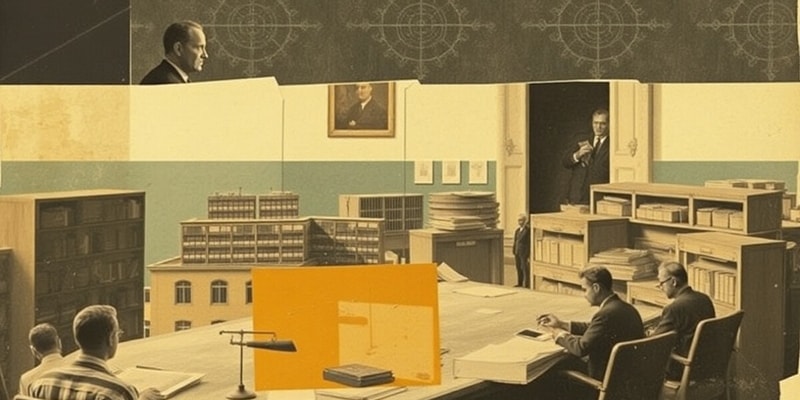Podcast
Questions and Answers
Which feature is characteristic of a mechanistic design?
Which feature is characteristic of a mechanistic design?
In which environment is an organic design more effective?
In which environment is an organic design more effective?
What type of communication is primarily utilized in a mechanistic organizational structure?
What type of communication is primarily utilized in a mechanistic organizational structure?
Which aspect represents an organic design as opposed to a mechanistic design?
Which aspect represents an organic design as opposed to a mechanistic design?
Signup and view all the answers
Which of the following statements best describes a bossless organization?
Which of the following statements best describes a bossless organization?
Signup and view all the answers
What is a primary function of organizations?
What is a primary function of organizations?
Signup and view all the answers
Which dimension refers to the division of labor within an organization?
Which dimension refers to the division of labor within an organization?
Signup and view all the answers
What does the term 'centralization' refer to in an organization?
What does the term 'centralization' refer to in an organization?
Signup and view all the answers
Which of the following is NOT a contextual dimension affecting organizations?
Which of the following is NOT a contextual dimension affecting organizations?
Signup and view all the answers
How is complexity in an organization measured?
How is complexity in an organization measured?
Signup and view all the answers
Which aspect does NOT contribute to the importance of organizations?
Which aspect does NOT contribute to the importance of organizations?
Signup and view all the answers
What does formalization in an organization refer to?
What does formalization in an organization refer to?
Signup and view all the answers
Which statement best describes the relationship between goals and strategy in an organization?
Which statement best describes the relationship between goals and strategy in an organization?
Signup and view all the answers
What role do organizations play in adapting to their environment?
What role do organizations play in adapting to their environment?
Signup and view all the answers
Which structural dimension indicates the extent to which an organization has documented rules and procedures?
Which structural dimension indicates the extent to which an organization has documented rules and procedures?
Signup and view all the answers
How is the concept of centralization best defined in organizational settings?
How is the concept of centralization best defined in organizational settings?
Signup and view all the answers
What does complexity in an organization primarily refer to?
What does complexity in an organization primarily refer to?
Signup and view all the answers
What does the term 'organizational technology' encompass?
What does the term 'organizational technology' encompass?
Signup and view all the answers
Which contextual dimension is focused on the number of employees within the organization?
Which contextual dimension is focused on the number of employees within the organization?
Signup and view all the answers
What primary outcome do organizations aim to achieve through the efficient use of resources?
What primary outcome do organizations aim to achieve through the efficient use of resources?
Signup and view all the answers
Which dimension of organization design primarily defines the reporting structure within the organization?
Which dimension of organization design primarily defines the reporting structure within the organization?
Signup and view all the answers
In organizations, what is the significance of having a diverse workforce?
In organizations, what is the significance of having a diverse workforce?
Signup and view all the answers
What aspect of organizational design does 'span of control' refer to?
What aspect of organizational design does 'span of control' refer to?
Signup and view all the answers
What is a primary characteristic of organic designs compared to mechanistic designs?
What is a primary characteristic of organic designs compared to mechanistic designs?
Signup and view all the answers
Which cultural aspect is indicative of a mechanistic design?
Which cultural aspect is indicative of a mechanistic design?
Signup and view all the answers
In which type of environment would you most likely find an organic organizational design?
In which type of environment would you most likely find an organic organizational design?
Signup and view all the answers
Which communication style is primarily associated with an organic organizational structure?
Which communication style is primarily associated with an organic organizational structure?
Signup and view all the answers
What role does empowerment play in an organic design?
What role does empowerment play in an organic design?
Signup and view all the answers
Which of the following best describes a distinctive feature of a bossless organization?
Which of the following best describes a distinctive feature of a bossless organization?
Signup and view all the answers
What type of technology is an organic design generally more suited for?
What type of technology is an organic design generally more suited for?
Signup and view all the answers
What aspect of organizational structure is emphasized more in mechanistic designs compared to organic designs?
What aspect of organizational structure is emphasized more in mechanistic designs compared to organic designs?
Signup and view all the answers
What is a key strategy focus for mechanistic designs?
What is a key strategy focus for mechanistic designs?
Signup and view all the answers
Which structural feature is least associated with an organic design?
Which structural feature is least associated with an organic design?
Signup and view all the answers
Study Notes
What is an Organization?
- Organizations are social entities, goal-directed, deliberately structured, and coordinated activity systems.
- They are linked to their external environment.
What is the Importance of Organizations?
- Bring together resources to achieve desired goals.
- Produce goods and services efficiently.
- Facilitate innovation.
- Use modern manufacturing and information technologies.
- Adapt to and influence a rapidly changing environment.
- Create value for owners, customers, and/or employees.
- Accommodate diversity, ethics, and coordination challenges.
Dimensions of Organization Design
Structural Dimensions
- Formalization: The extent of written documentation (e.g., policies, procedures). Highly formalized organizations have extensive rules, while informal organizations have less.
- Specialization: Division of labor. High specialization means employees perform narrow tasks, low specialization means broader tasks.
- Hierarchy of Authority: Defines who reports to whom, related to span of control (number of people a manager supervises). Narrow span leads to tall hierarchy, wide span to shorter hierarchy.
- Complexity: Number of distinct units or activities within an organization. Measured vertically (levels of hierarchy), horizontally (departments), and spatially (geographical dispersion).
- Centralization: The level where decision-making authority resides. Centralized organizations make decisions at the top, decentralized organizations delegate authority to lower levels.
Contextual Dimensions (Contingency Factors)
- Size: Typically measured by the number of employees. Reflects the human aspect of the organization, unlike sales or assets.
- Organizational Technology: Tools, techniques, and processes used to convert inputs into outputs.
- Environment: All external elements influencing the organization.
- Goals & Strategy: Define an organization's purpose and competitive approach. Goals express intent, strategy details resource allocation & activities needed to achieve goals.
- Culture: Shared values, beliefs, and norms among employees, providing cohesion.
The Contrast of Organic & Mechanistic Designs
-
Organic Design:
- Small size
- Innovative strategy
- Changing environment
- Adaptive culture
- Works for service technology
-
Mechanistic Design:
- Large size
- Efficiency strategy
- Stable environment
- Rigid culture
- Works for manufacturing technology
Structural Dimensions (Organic and Mechanistic Design Continued)
-
Organic Design:
- Decentralized structure
- Collaborative teamwork
- Empowered roles
- Horizontal communication
- Few roles, informal
-
Mechanistic Design:
- Centralized structure
- Strict hierarchical authority
- Specialized roles
- Vertical communication
- Many roles, formal
The Emerging Bossless Design Trend
- Some organizations are adopting a "bossless" design.
- These organizations typically have no job titles, seniority, managers, or executives.
- Employees work together on an equal basis.
Studying That Suits You
Use AI to generate personalized quizzes and flashcards to suit your learning preferences.
Related Documents
Description
This quiz explores key concepts related to organizations, including their definitions, importance, and the dimensions of organization design. Participants will gain insights into how organizations function and adapt to changes in their environment.




